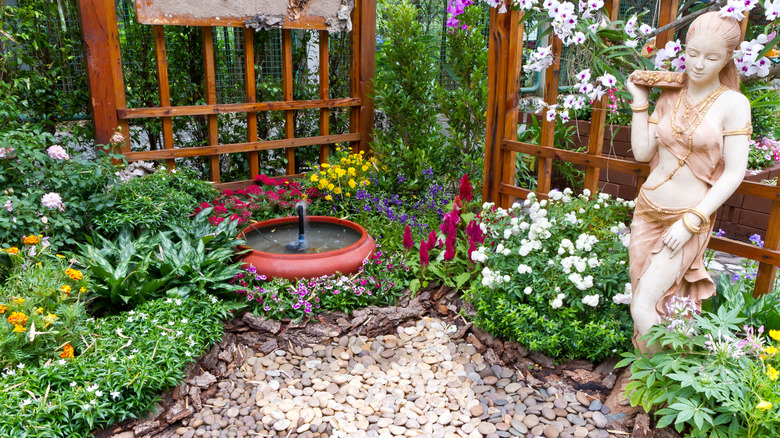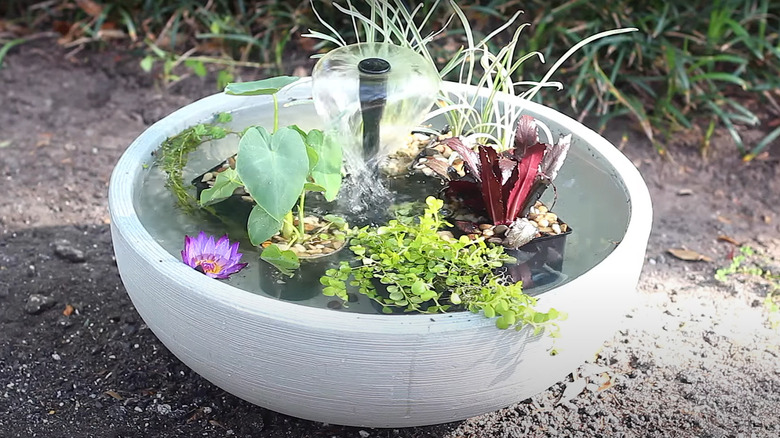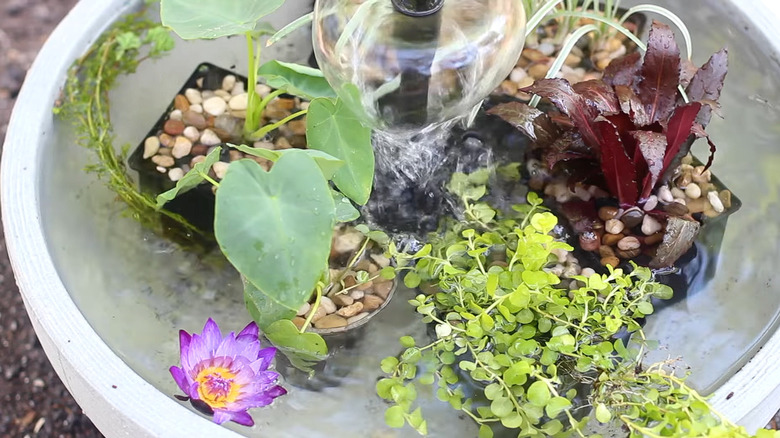The Mini Garden Feature That Will Transform Your Backyard Into A Stunning Oasis
Fans of water-feature gardens like to say that they are straightforward to put together, and that's true, but if you're not familiar with the basics of a water garden, it can all be quite alien. You can learn a lot and get a surprising amount of drama from a small pot with a simple planting — perhaps even more than with a typical half-whiskey barrel filled with exotic-seeming plants. Everything you learn building the smallest water garden will apply to the largest you make later. We'll walk you through the simplest version — a miniature container water garden — so you can get a feel for the fundamentals and the possibilities. But stay confident, because water gardens, like garden water features, don't have to be difficult to make.
There are a few reasons you get such a fantastic effect from a miniature water garden. The containers themselves are often more visually appealing than the larger, more utilitarian barrels and the like. They are usually planted more sparsely, emphasizing individual plants. The fountain part tends to be more immediately charming than even the most elaborate in-ground waterfall because they tend to either shoot water up to more height than you'd expect or use fun, sculptural, and sometimes kitschy spouts to deliver the stream of water. Like their full-size cousins, mini water gardens and water features have a lot of benefits, and you should be adding one to your landscape.
The basics of a miniature container water garden
The common gardening metaphor of "good bones," representing well-considered and well-constructed structure and infrastructure in a garden, is particularly important for water gardens. It all starts with the pot. You want one proportionally wide and shallow but deep enough to hold the plants' nursery containers. You can use any size, but something in the area of 16 inches in diameter is a good choice. Into the pot, you'll place a fountain pump, ideally one with a vertical spout, so that no further routing of water is necessary. It'll just bubble or shoot up like its bigger cousins in the sort of fountains you'd see in a town square.
If your little pond has a front, put your taller plants toward the back; if not, place them in the center. Just drop in the entire pot from the nursery. A good phrase to remember when selecting and locating plants is "thrillers, fillers and spillers," representing tall, dramatic plants, medium-height filler plants, and plants that spill over the container's edge. Use the plants to conceal the pump and power cord. Weight the nursery pots down with pea gravel or slightly larger rounded stones. Fill it with water, turn on the pump, and enjoy!
What to learn about next
Wherever you're going with your water gardening, you can get there from here. Mini-water gardens, larger containers like barrels, and in-ground water gardens all share the same basics. It might be good form to start by talking about soil and the media in which water plants are grown, but it's more fun to learn about the plants first. You'll be nurturing four basic types of plants: floating-leaf aquatics, grasses, bog plants, and marginal plants like horsetail. In a nutshell, floating-leaf plants like water lilies shade the water and prevent an overgrowth of algae. Grasses add height, oxygenate the water, and help maintain proper pH. Bog plants occupy shallow water but sometimes, as with pitcher plants, add a lot of visual interest. Water gardeners tend to talk about marginal plants. The concept is not quite as relevant to a mini-garden as to larger ones, but it's simple enough: These plants tend to occupy the edges in natural settings.
Now, back to the soil — you won't have any. Or, more precisely, you won't have any potting soil but will instead use aquatic soil, a manufactured substrate that holds nutrients and anchors plants well. Natural clay soil is also good for anchoring and nutrients, though too much can cloud your water. There is also gravel, which is strictly structural. Some sources recommend cat litter for small water gardens. Since it's basically clay, you can think of it as a variation of clay soil.


